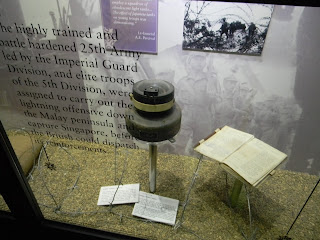Visited The Reflections At Bukit Chandu Museum this morning.
Signboard Pointing to the Reflections at Bukit Chandu
Front View of the Museum
Side View of the Museum with the Painting of the battle of Pasir Panjang
A close up view of the painting
Description of the words engrave on the plaque
Part 2
Here I will describe about Leftenan Adnan, The Malay Regiment and The Battle of Pasir Panjang.
The Malay Regiment History
The 1st Malaya Infantry Brigade was a regular infantry brigade formed in 1939 with its headquarters in Singaporeimmediately after the outbreak of hostilities in Europe. The Brigade participated in the Battle of Singapore against theJapanese until the surrender of the garrison in February 1942.
Logo of
Malay Regiment
Meaning of the Arabic word engrave on the crest is " Taat Setia "
Uniform worn by The Malay Regiment
The Ceremonial Dress of The Malay Regiment
Malay Regiment officer's Uniform
Adnan bin Saidi, (1915 – 14 February 1942), was a Malayan soldier of the 1st Infantry Brigade which fought the Japanese in the Battle of Singapore. He is regarded by Malaysians and Singaporeans today as a hero for his actions on Bukit Chandu.
Biodata Of Leftenan Adnan
Biodata Of Leftenan Adnan
The Battle Of Pasir Panjang
On 14 February, the Japanese again launched a heavy attack at 8.30am, supported by intense mortar and artillery fire, on the front held by the 1st Malay Brigade.[3] The defenders beat off this and a number of other attacks. The fighting included bitter hand-to-hand combat, and losses from both sides were heavy. At 4.00pm an attack supported by tanks eventually succeeded in penetrating the left, and the defenders on this flank were forced back to a line from the junction of the Ayer Rajah and Depot Road through the Brick Works and along the canal to Bukit Chermin. Owing to the failure of units on both its flanks to hold their ground, the 1st Malay Brigade withdrew at 2.30pm. It was at this point that C Company of the Malay Regiment received instructions to move to a new defence position, Bukit Chandu.
Bukit Chandu (means "Opium Hill" in Malay) was named after an opium-processing factory located at the foot of the hill. This was also where C Company of the Malay Regiment made their final stand against the Japanese attack. Bukit Chandu was a key defence position for two important reasons. It was situated on high ground overlooking the island to the north; and secondly, if the Japanese gained control of the ridge, it gave them direct passage to the Alexandra area. The British army had its main ammunition and supply depots, military hospital and other key installations located in Alexandra.
C Company's position was separated from D Company by a big canal. Oil was burning in the canal, which flowed from Normanton Depot. The burning oil prevented C Company soldiers from retreating further south. The company was under the command of Captain H. R. Rix, a British officer. He encouraged the men to defend Bukit Chandu down to the last soldier, and was killed, together with many of his Malay Regiment soldiers in the last defensive battle at Pasir Panjang.
The Japanese pressed their attack on Bukit Chandu in the afternoon, but under the guise of a deception. They sent a group of soldiers, dressed in Punjabi uniforms, passing themselves off as Indian soldiers in the British army. C Company saw through this trick as they knew that soldiers of the British army usually marched in a line of three whereas the disguised soldiers were in a line of four. When they reached the Malay Regiment's defensive line, C Company's squad opened fire, killing several men. Those who survived escaped downhill.
The Last Stand
2 hours later, the Japanese launched an all-out banzai charge in great numbers. The attack overwhelmed the Malay Regiment, and the defence line shattered. Greatly outnumbered and short of ammunition and supplies, the Malay Regiment continued to resist the Japanese. Both sides engaged in fierce hand-to-hand combat using bayonets. Adnan was seriously wounded but refused to retreat or surrender and instead encouraged his men to fight to the end.
Soon after, Pasir Panjang was under Japanese control, and Adnan, wounded and unable to fight, was captured. Instead of taking him prisoner, the Japanese continuously kicked, punched and beat him before tying him to a cherry tree and stabbing him to death with their bayonets.
Part 3
Some of the Items Display At The Reflections At Bukit Chandu Museum
Weapons Used By The Malay Regiment During The Battle Of Pasir Panjang
Mortar
Lee Enfield Rifle
Bren Mark 2 Machine Gun
Vickers Mark 1
Tribute To Leftenan Adnan Saidi And The Malay Regiment
Head statue Of Leftenan Adnan in the Reflections At Bukit Chandu Museum to honour his bravery in defending Bukit Pasir Panjang till his last breath.
" Death Before Dishonour "
Poem written to honour Leftenan Adnan and The Malay Regiment
Remembering Our Heroes who gave their lives defending our country.








































No comments:
Post a Comment